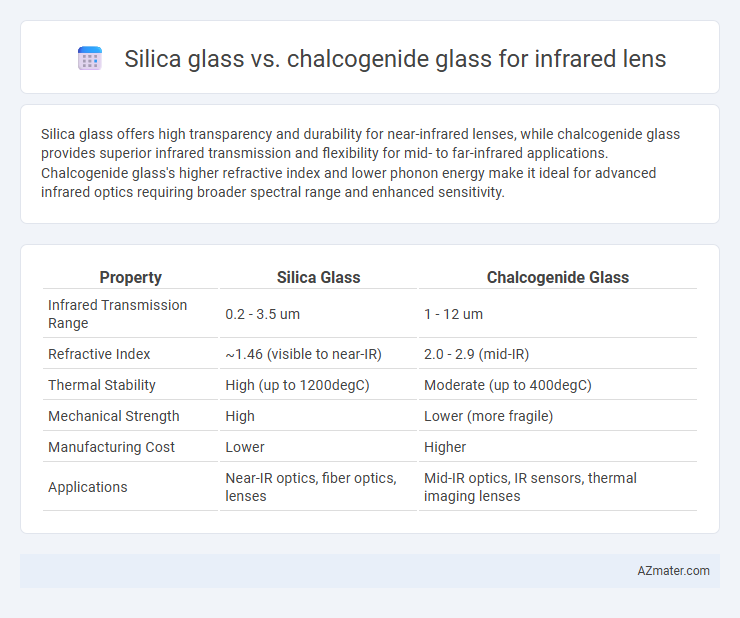Silica glass offers high transparency and durability for near-infrared lenses, while chalcogenide glass provides superior infrared transmission and flexibility for mid- to far-infrared applications. Chalcogenide glass's higher refractive index and lower phonon energy make it ideal for advanced infrared optics requiring broader spectral range and enhanced sensitivity.
Table of Comparison
| Property | Silica Glass | Chalcogenide Glass |
|---|---|---|
| Infrared Transmission Range | 0.2 - 3.5 um | 1 - 12 um |
| Refractive Index | ~1.46 (visible to near-IR) | 2.0 - 2.9 (mid-IR) |
| Thermal Stability | High (up to 1200degC) | Moderate (up to 400degC) |
| Mechanical Strength | High | Lower (more fragile) |
| Manufacturing Cost | Lower | Higher |
| Applications | Near-IR optics, fiber optics, lenses | Mid-IR optics, IR sensors, thermal imaging lenses |
Introduction to Infrared Lenses
Silica glass offers superior transmission in the near-infrared range up to approximately 2.5 microns, making it ideal for infrared lenses in telecommunications and certain imaging applications. Chalcogenide glass extends infrared transmission significantly further, often from 2 to 12 microns, enabling lenses used in thermal imaging, spectroscopy, and military sensing systems. The choice between silica and chalcogenide glasses depends primarily on the specific infrared wavelength range and environmental durability requirements for the lens application.
Overview of Silica Glass Properties
Silica glass, known for its high thermal stability and excellent optical transparency in the near-infrared range up to about 2.5 microns, offers superior hardness and chemical resistance compared to chalcogenide glass. Its low thermal expansion coefficient and high melting point make it ideal for precision infrared lenses requiring durability under extreme conditions. However, silica glass has limited transmission beyond 2.5 microns, where chalcogenide glass holds advantages in mid to far-infrared applications.
Overview of Chalcogenide Glass Properties
Chalcogenide glass exhibits excellent infrared transmission, covering a broad wavelength range from 1 to 12 micrometers, making it superior to silica glass, which typically transmits up to 2.5 micrometers. It possesses high refractive indices between 2.0 and 3.0, enabling compact, efficient lens designs with strong light-bending capabilities. Its lower thermal conductivity and higher nonlinear optical properties are advantageous for specialized infrared lens applications in sensing and imaging systems.
Transmission Range in the Infrared Spectrum
Silica glass exhibits strong transmission in the near-infrared range, typically from 0.3 to about 3.5 micrometers, making it ideal for standard infrared lens applications. Chalcogenide glass extends transmission significantly into the mid-infrared spectrum, covering wavelengths roughly from 1 to 12 micrometers, which is beneficial for thermal imaging and spectroscopy. The broader transmission range of chalcogenide glass enables enhanced performance in infrared detecting and sensing devices beyond the capabilities of silica glass.
Thermal Stability and Environmental Durability
Silica glass exhibits superior thermal stability with a high softening point around 1700degC, making it ideal for infrared lens applications requiring resistance to thermal deformation. In contrast, chalcogenide glass, while offering broader infrared transmission (1-14 um), has a lower glass transition temperature typically between 200-350degC, limiting its performance under high-temperature conditions. Regarding environmental durability, silica glass is highly resistant to moisture and chemical attack, whereas chalcogenide glasses are more prone to oxidation and moisture-induced degradation, necessitating protective coatings for extended outdoor use.
Refractive Index Comparison
Silica glass exhibits a refractive index around 1.44 in the infrared spectrum, offering excellent transparency and minimal dispersion for IR lens applications. Chalcogenide glass has a significantly higher refractive index, typically ranging from 2.0 to 3.0, enabling stronger light bending and improved infrared focusing capabilities. This higher refractive index of chalcogenide glass allows for more compact lens designs and enhanced performance in mid- to far-infrared optical systems.
Machinability and Fabrication Techniques
Silica glass offers excellent machinability with established fabrication techniques such as precision grinding, polishing, and laser micromachining, making it ideal for high-quality infrared lenses with minimal surface roughness. Chalcogenide glass, while more challenging to machine due to its brittleness and softer structure, benefits from specialized molding and warm-pressing methods that enable complex infrared lens shapes but require careful thermal management to prevent deformation. The choice between silica and chalcogenide glasses for infrared optics depends heavily on the desired fabrication precision and production volume, balancing machinability constraints with the infrared transmission range needed.
Cost and Availability Analysis
Silica glass offers widespread availability and lower cost due to established manufacturing processes and abundant raw materials, making it a cost-effective choice for infrared lenses in common applications. Chalcogenide glass, although more expensive and less readily available, provides superior infrared transmission especially in the mid-IR range, justifying its cost for specialized or high-performance optical systems. The cost differential largely stems from complex synthesis and limited production scale of chalcogenide glass compared to the mature supply chain of silica-based optics.
Typical Applications in Infrared Optics
Silica glass is commonly used in infrared optics for applications requiring high durability and broad spectral transmission, such as infrared windows, laser delivery systems, and spectroscopy equipment operating mainly in the near-infrared range (up to about 2.5 microns). Chalcogenide glass excels in mid-infrared applications due to its superior transmission beyond 2.5 microns, making it ideal for thermal imaging, chemical sensing, and environmental monitoring lenses that require sensitivity in the 3-12 micron range. Both materials are essential in designing infrared lenses tailored to specific wavelength requirements, balancing transmission range, mechanical properties, and environmental resistance.
Conclusion: Choosing Between Silica and Chalcogenide Glass
Silica glass offers excellent durability and transparency in the near-infrared range up to about 2.5 microns, making it ideal for applications requiring high mechanical strength and thermal stability. Chalcogenide glass provides superior transmission in the mid- to far-infrared spectrum, extending beyond 10 microns, and is preferred for advanced sensing and thermal imaging despite its lower durability and higher cost. Selecting between silica and chalcogenide glass depends on the specific infrared wavelength requirements and environmental conditions of the intended lens application.

Infographic: Silica glass vs Chalcogenide glass for Infrared lens
 azmater.com
azmater.com